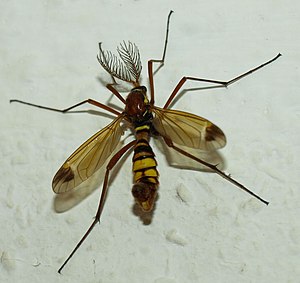Ctenophora ornata
| Ctenophora ornata | ||||||||||||
|---|---|---|---|---|---|---|---|---|---|---|---|---|

Ctenophora ornata , male |
||||||||||||
| Systematics | ||||||||||||
|
||||||||||||
| Scientific name | ||||||||||||
| Ctenophora ornata | ||||||||||||
| Meigen , 1818 |
Ctenophora ornata , which is also known as Cnemoncosis ornata , is a species of fledgling from the genus of the crested snake ( Ctenophora ). Like all species of flies, they cannot sting.
features
The Schnake is 20 to 22 millimeters long, the wingspan is 30 to 40 millimeters. It is noticeably colored: the thorax and abdomen are light brown to dark reddish, the 4th and 5th abdominal segments are dull yellow. The neck ring is also yellow. There is a large dark spot at the end of the otherwise transparent forewings. The male animals have long combed antennae. The antennae are very short in the females. Another distinguishing feature between the sexes is that in the females the abdomen is developed into a conspicuous ovipositor .
They can be distinguished from Ctenophora festiva in that the wing spots are smaller. In Ctenophora magnifica the hind legs have dark sections, while in C. ornata the legs are reddish throughout. C. magnifica is also only found in Azerbaijan and northern Iran . C. atrata , the black comb snake , is darker in color and has smaller antennae. The exact differentiation between the four Ctenophora species occurring in Germany and a total of 15 in Europe can be difficult, as the color tones of the segments can vary within a species.
distribution
From June to August Ctenophora ornata can be found in alluvial forests and riverside areas. At night, the kind of artificial light sources is attracted. The occurrence is limited to the western Palearctic . It is widespread in Europe, but not common anywhere. Regionally, their existence is threatened by the displacement of old deciduous forests , which make up a large part of their habitat, for example in Ireland .
Life cycle
The larvae live in the silt of old trees, especially beeches , feed on it and dig passages there. Trees with large girth and in an advanced stage of decay are preferred for oviposition. Another preference is that the place be shady.
swell
Individual evidence
- ↑ Pjotr Oosterbroek, Rune Bygebjerg, Thorkild Munk: The West Palearctic species of Ctenophorinae (Diptera: Tipulidae): key, distribution and references . Entomological Reports 66 (5), p. 146 ( PDF , English;; 1.259 MB)
- ^ Bob Gibbons: Insects van Northwest Europe . ANWB Media, Den Haag 2005, p. 148, ISBN 90-18-02142-3 . (Dutch)
- ↑ Philip Buckley: Ireland's First National Report, 2001, p. 28 (PDF, English; 461 kB)
- ↑ Transactions of the Royal Entomological Society of London, Issue 108, 1956, p. 411 (English)
- ↑ Polish Red Data Book of Animals (English)
literature
- Joachim Haupt, Hiroko Haupt: Flies and Mosquitoes. Observation, way of life . Naturbuch Verlag, Augsburg 1998, p. 92, ISBN 3-89440-278-4 .